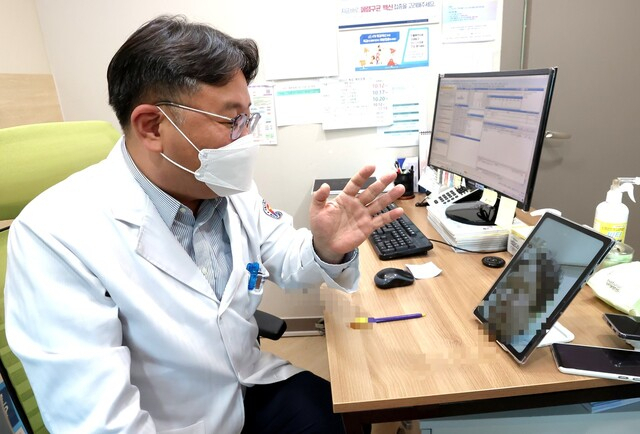Politicians push for telemedicine amid doctors’ walkout
Telehealth visits via phone or video calls surge as hospitals suffer from staff shortages
By Shim Woo-hyunPublished : April 10, 2024 - 19:40

Discussions on expanding telemedicine services are speeding up here as no immediate breakthrough can be seen in the prolonged mass walkout by junior doctors in protest against the government’s push to raise the admission caps of medical schools.
Ahead of Wednesday’s General Election, candidates from both ruling and opposition parties also announced pledges to expand the availability of telemedicine services. Currently, remote clinical services via phone or video calls are offered on limited occasions as part of the government’s pilot programs.
“Both patients and health care workers have become increasingly tired of the prolonged walkout for months. It is still difficult for new patients to see doctors and health care employees suffer from a shortage of professional manpower. Telemedicine services seem to have emerged as an option to tackle the problem,” an industry official said.
Demand for telemedicine services has significantly increased after the doctors’ walkout that started in mid-February. According to the Korean Telemedicine Society, the number of telehealth visits made via online platforms reached 155,599 in March, a six-fold increase from 23,638 in November last year. The upward trend shows no sign of abating in April with the prolonged walkout.
“The weekly number of telehealth visits almost doubled in April, when compared to the weeks before the walkout,” said an official from Doctornow, one of the latest telemedicine platforms here.
Of the total, patients with cold-related symptoms accounted for some 20 percent of the total telehealth visits. According to Doctornow, telemedicine visits for pediatric care also accounted for 35 percent of the total.
"Many people seemed to have chosen telehealth visits as an alternative to going to small- and mid-sized clinics, which became increasingly crowded with patients (whose appointments get canceled and rejected at larger hospitals)," the Korean Telemedicine Society explained.
Telemedicine services were first introduced in 2014 here as a pilot program and became more widely available during the COVID-19 pandemic due to social-distancing rules and infection concerns.
In June last year, the government, pressured by interest groups of doctors and pharmacists, prohibited first-time patients from using telemedicine platforms and suspended drug delivery services. The government allowed first-time patients to use the online platforms only if they are living in a few designated medically vulnerable areas that have limited access to hospitals or if they have physical disabilities or infections.
After months of adjustments, the government further expanded the service in February, fueled by the recent walkout of doctors. Telemedicine services became available to any first-time patients, allowing those who live outside of “medically vulnerable” regions to also use telehealth services – an emergency measure to support people suffering from staff shortages due to the walkout.
The government and the National Assembly have been seeking to revise related laws to expand telemedicine services since last year. But no agreement has been made among different parties amid fierce resistance from doctor groups.
The situation, however, changed after the doctors’ walkout, which brought widespread complaints from the public. Both ruling and opposition parties made election pledges to expand the availability of telemedicine services to appeal to the public during their campaigns for the country’s parliamentary elections.
The ruling party, in particular, promised that it would push ahead with providing a legal basis by amending the Medical Service Act. The party also said it would try to allow drug deliveries here, while the opposition party is taking a more conservative approach to the services.
Local telemedicine platform companies are relatively more in favor of the ruling party’s proposals. “Without drug delivery services, telemedicine solutions are half-done,” an official from a local telemedicine company said on the condition of anonymity. The official added, “It is still positive that both parties have included telemedicine services as part of their election pledges, although it is difficult to say whether the National Assembly will be able to soon legalize telemedicine services.”
If the National Assembly passes amendments after the election, startups operating related services, in particular, are expected to benefit the most. It is also because large-sized digital health care companies, like Kakao Healthcare, may not enter the market, industry sources said.
“Because large pharmaceutical and digital health care companies are cooperating with doctors and hospitals in many areas, it could be difficult for them to launch telehealth services that doctor groups do not favor,” an official from one of the top five pharmaceutical companies said.
Industry sources expressed hope that the recent efforts to legalize telehealth services do not end in vain. “The number of doctors will eventually decrease in the future, and the country will need telemedicine services in one way or another soon. The government and doctors should focus more on the actual benefits that telehealth services can provide, instead of using them as political tools,” an official from the Korean Telemedicine Society noted.



















![[Today’s K-pop] Treasure to publish magazine for debut anniversary](http://res.heraldm.com/phpwas/restmb_idxmake.php?idx=642&simg=/content/image/2024/07/26/20240726050551_0.jpg&u=)